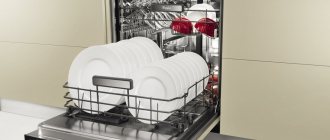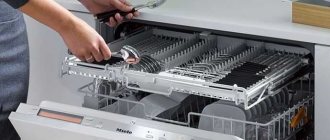If you bought a built-in dishwasher, then you now face several difficult tasks. You have probably already become acquainted with some of them earlier, when installing a washing machine. Indeed, in many ways these household devices are similar - the same connection to the drain, connection to the electrical network. However, a new task appears before you - fastening, installing the facade to the dishwasher. Many people think that this is an activity for furniture assemblers; however, installing a facade with your own hands is not difficult. In this article we will tell you what can be useful for carrying out such work.
How to install a dishwasher under the façade
Before starting work, read the installation instructions and make sure you can handle the job. Remember to follow safety precautions. It is useful to watch a current video, e.g.
To begin with, installation of communications is carried out: water supply, sewerage, electrical network. Only after a test check can the PMM be secured in a niche, under the tabletop, and a decorative panel hung. Fastening is done with bolts (screws, self-tapping screws) included in the kit. Along with fasteners, gaskets, instructions, you will find a stencil. Applying it to the cabinet walls, countertop (depending on the PMM model), draw the locations of the holes for fastening. They are easy to make with a hammer drill. Do not make through holes; drilling ¾ of the wall thickness will be enough. All that remains is to screw on the countertop protection and place the dishwasher in the cabinet. Last steps:
- Attach fittings, slider mechanism (if necessary).
- After attaching the stencil, determine the attachment points on the inner surface of the facade.
- Use a narrow drill to drill points, not all the way through, to avoid damaging the exterior finish.
- Remove the transport screws from the door (if equipped).
- If you are working without an assistant, try temporarily fixing the facade on the door with double-sided tape so that you can easily screw in the fastening bolts in the right places.
- Check the tightness of the fit, the quality of fixation, locking, and the presence of interference when opening and closing.
What does the locking mechanism consist of?
First, let's look at the internal structure of the PMM to make it easier to determine the breakdown.
The locking mechanism is located inside the door and consists of the following elements:
- metal spring;
- cable (metal or fabric);
- plastic locking element;
- loops.
Some models, such as Bosch, also have closers that make the door move smoother.
The mechanism of operation of this system is simple. You open the dishwasher and thereby set the hinges in motion. This increases the tension of the cable, and it, after itself, stretches the spring. When the spring is stretched to its maximum, the locking element falls into a special hole and fixes the structure, preventing the spring from closing. At this moment, the PMM can safely be in the open position. As soon as you want to close it and move the door up, the lock will come out of the grooves and allow the spring to slam the door.
That is why PMMs that are not equipped with closers should be held when closing. If this is not done, the door will slam loudly and there will be a jerk that can damage the internal mechanisms or the housing.
At what stage should the façade be attached?
The dishwasher is installed in several stages. The main connection is considered to be connection to communications: water supply, sewerage system, dedicated power line.
Decorating the front side is usually done at the very end, when the rest of the work has already been completed.
The housing is pulled out of the niche to provide access to the car door from all sides. But during the fitting process, it is better to push the machine into place so that the panels of the dishwasher and neighboring modules are at the same level
Is it possible to run the dishwasher without the decorative trim installed? It is not recommended to launch before installation work is completed for several reasons.
Only a dishwasher that is completely closed on all sides can fully perform its functions; in addition, the panel plays the role of an additional sound and heat insulator.
Sometimes they mask the machine first and then make the connection. This option is appropriate if there is a delay in connection for objective reasons, for example, at the same time the riser in the toilet is being replaced or a new power line is being laid.
In order not to waste time, decorate slowly.
Mounting methods
It is no secret that fixing the panel is very important; special attention must be paid to it.
There are two ways to attach the facade.
Partial fastening . In this case, the panel covers the main part of the door, while the control panel remains visible.
Full installation. The dishwasher door is completely covered by a panel.
The most common fastening is using self-tapping screws. They are screwed in from the inside. It is necessary to choose the correct length of screws. This way you can avoid seeing the screw heads on the outside of the panel. Another common fastening is hinges. They can be purchased complete with the facade. They are attached near the bottom edge of the dishwasher.
It is strictly forbidden to attach the facade to any kind of glue. During operation, the dishwasher door can either heat up or cool down, depending on the dishwashing mode. Due to such differences, the glue may lose its properties and, as a result, the panel will fall off. It is also possible that the glue will firmly stick the panel to the device door, which is also inconvenient. If dismantling is necessary, it will be impossible to peel off the panel. Another mistake is to glue the panel with tape. This fastening is not enough to hold the panel. While the machine is operating, the facade may simply fall off.
When to hang a façade
The façade panel is fastened after all other communications have been connected to the machine. The device must be tested at idle to ensure that all mechanisms are working properly. And only then should you start hanging the façade plate.
Since it is necessary to accurately adjust the dimensions, the installation process includes alignment of the PMM in height, slope, and fastening to your own or adjacent cabinets.
In some cases, the design of the machine itself or kitchen furniture requires a specific installation approach: installing an additional false panel, adjusting the base strip, etc.
Each model has its own installation features. Sometimes manufacturers of furniture sets indicate which models of dishwashing units are best suited for their products. Large holdings, of which IKEA is the most famous, produce cars themselves in addition to furniture. In such cases, installation of the front panel is carried out without problems.
Nuances of installing built-in equipment
Free-standing units are simply installed in the place provided for them, and then connected. Built-in models need to be integrated into a furniture set.
Here are some useful tips that may come in handy during the installation of built-in appliances:
- the dimensions of the built-in cabinet must correspond to the dimensions of the dishwasher body; for comparison, you need to check the diagrams provided by the manufacturer;
- be sure to use the protective devices that are included in the kit - a metal strip to strengthen the tabletop, a vapor barrier film;
- to level the body, twist the legs, usually there are three of them - two are in the front and one in the back;
- do not forget to insert the side bushings and secure the body with self-tapping screws;
- Fix decorative panels strictly according to templates or stencils, which are also included in the delivery set.
Dishwashers from different manufacturers may have structural differences, so you should rely only on the instructions for the specific model.
This article clearly outlines how to properly install a dishwasher, in what order you need to carry out the installation and connection of communications.
Preparatory activities
Experts recommend that before attaching the facade panel, preparatory work is carried out, during which the necessary materials and tools are prepared.
Tool
To perform installation work, you will need special working tools, among which are the following:
- Screwdrivers. These are common tools that are found in almost every home. Most often they are used if it is necessary to screw in screws and screws. Screwdrivers may differ in purpose and size. The choice of suitable models depends on the type of fastenings used.
- Roulette. When carrying out installation work, it is necessary to take various measurements. For this, a tape measure is used, with which you can take measurements.
- Screwdriver. This is a hand-held electric tool that is often used for driving and unscrewing self-tapping screws, screws and screws. You can also use it to drill holes into which fasteners will be installed in the future.
- Marker or pencil. They will be needed to mark the places where the mounting holes will be drilled.
- Awl. This tool is used if you need to pierce holes in fragile surfaces. It is recommended to use a strong awl to prevent it from breaking during the piercing process.
Materials
To install the facade you will not need as many materials as tools. Among the most important materials are:
- Stencil. This is a very important detail that can help when installing the facade. With its help, the places where the mounting screws will be installed are marked. To use a stencil, you need to attach it to the panel and mark the places for fastenings.
- Scotch. For installation work, it is recommended to use double-sided tape. You will need it to attach the façade to the surface before screwing in the screws.
Preparation of tools and materials
No special tools are required to secure the façade trim.
The same items that are used to install the dishwasher as a whole will be useful:
- drill;
- screwdriver;
- awl;
- screwdriver;
- tape measure or ruler;
- pencil or marker.
If you don’t have a power tool, then one screwdriver is enough - you can screw in the screws by hand if the holes for them are pre-drilled.
The drill bit is selected according to the diameter of the screws: the holes should be a little tighter so that the fasteners are held firmly in the sockets
The work is simplified by the presence of a stencil for the façade overlay included in the delivery set. It is a large sheet of thin paper with marked attachment points.
The stencil is placed on the back side of the decorative panel and the places where the screws are screwed in are marked.
In addition to the tools, you will need double tape. Several “Velcro” pieces of tape will come in handy when you need to try on the facade. It is not recommended to immediately “mount” it on screws, since an error of 2-3 millimeters will mean all the work is in vain.
Don’t forget about the handle, without which opening the door will be problematic. It is also fixed with self-tapping screws, which are screwed into the back of the panel.
To ensure that the surfaces of the door and facade adjoin as tightly as possible, the heads of the screws should be recessed into the canvas.
It is easier to attach the workpiece than a homemade overlay. If you make the panel yourself, you may need carpentry tools, sandpaper for sanding, antiseptic impregnation and paint to finish the entire surface or just the ends.
Photos of dishwashers with furniture fronts
In any case, a facade masking a dishwasher will help create the desired interior without the difficulty of selecting equipment of a certain design. In addition, it will protect equipment from aggressive factors and extend its service life.
The difference between installing a built-in dishwasher and a freestanding model is that additional design is required for the front wall - the machine door.
It is assumed that the decorative panel is selected to match the surrounding interior, and then the facade is installed on the dishwasher.
Experienced craftsmen cope with a simple operation quickly, but beginners should carefully study the instructions and become familiar with some of the installation nuances.
The range of models integrated into kitchen units is much wider than their free-standing counterparts. This is explained by the principles of ergonomics and space saving inherent in the concept of constructing a kitchen interior.
To install a built-in dishwasher, you will need a separate cabinet, or rather, a niche in the set. It differs from a regular kitchen cabinet in that it does not have a back wall or bottom.
The equipment is built inside furniture modules and decorated with facade panels so that when closed it is completely hidden. This installation method allows you to maintain the kitchen interior in the same style.
The machine is installed directly on the floor, on 3 or 4 support legs. The absence of a rear wall allows for free placement of the water supply and drain hoses.
The cabinet must have reliable walls to which the dishwasher body is attached, and a “roof” - the countertop. The front panel is not fixed to the walls, like conventional cabinets, but directly to the car door.
No need to experiment with fasteners
: Manufacturers have provided installation features and prepared special holes for self-tapping screws.
What is a facade for PMM? This is a decorative panel, most often made of the same material as the front surface of the entire kitchen unit. It is made from MDF, plastic, laminated chipboard, solid wood or combined materials.
The fasteners are not visible from the outside, since installation is carried out from the inside, from the side of the machine door. Self-tapping screws are screwed into the holes and partially, not completely, enter the panel fabric
Where do you get decorative panels? There are several ways to make it:
- ordered together with a kitchen set if the dimensions of the machine are known in advance;
- make it yourself from the doors of a disassembled kitchen cabinet;
- if there is no suitable “extra” facade, they are selected in a similar style and color design.
The first method is considered the most practical: when ordering, all dimensions of the car are taken into account, so the facade “fits” perfectly.
Design features of built-in PMMs
From a design point of view, a wide range of models of built-in dishwashing units can be divided into two types:
- Partially built-in, in which when the front door is closed, access to the control panel remains.
- Fully built-in, completely merging with the furniture, and from the outside looking like an ordinary wardrobe.
The machine can be mounted from the side (to a separate cabinet or adjacent walls), from above (to the countertop). Some machines have the ability to mount in two ways at once.
It itself is installed directly on the floor, on legs that are height adjustable. The drainage and water supply connections are made from the rear side. Accordingly, a separate cabinet without a bottom and also without a back wall must be provided for installation.
When the PMM is placed flush with the rest of the set, there remains a gap between its back panel and the kitchen wall sufficient for technical wiring.
Types of dishwashers
Modern dishwashers are divided into three main types:
- Tabletop;
- Freestanding;
- Built-in.
The smallest machine is a desktop model. Its dimensions allow the unit to be installed directly on the countertop. Free-standing models only require connection to the power supply and communications; they are installed as a separate module or in the niches of a kitchen unit. It is the built-in models that cause the most difficulties when installing communications and installing the machine itself, which will be discussed below.
The advantage of a built-in dishwasher over other models is that they do not destroy the integrity of the designer’s idea or simply do not violate the aesthetics of the interior of the room. Built-in dishwashers are hidden under a box that is part of the kitchen unit, and their facades are covered with decorative facades. If your kitchen is small, then the built-in model is just for you.
Even when placing an order for a new kitchen, the installation of a built-in dishwasher can be ordered from specialists. But this is not always convenient due to extra costs. In addition, in order to correctly accept the work in order to avoid further troubles, you should delve into the nuances of the installation carefully.
Housing Installation
After connecting to the power supply and communications, the dishwasher is leveled by adjusting the height of the legs. Before integrating it into a furniture set, it is necessary to carry out a test run without dishes, but with detergent
To properly install a dishwasher, you should pay attention to some points:
It is recommended to cover the furniture body with a vapor barrier on the inside to extend its service life. If the support of the machine is not the floor, but the base of the headset, it must be strong and installed at a horizontal level. It is not recommended to install the dishwasher box near a hob or electric oven. When adjusting the height of the machine, it is important to take into account the fact that the height of the dishwasher must correspond to the level of the countertop.
For normal operation of the dishwasher, its body must be strictly level.
To hide the dishwasher from prying eyes, a decorative facade is mounted to the machine door. Built-in dishwashers are supplied with special templates for fastening the façade. The fastening elements are installed in the grooves on the machine body and the decorative panel or door is installed.
Types of Dishwashers
Dishwashers in the kitchen, designed to make the housewife’s work as easy as possible, should not create discomfort, disrupt the design or take up a lot of space in a small kitchen. Before you build a dishwasher into your kitchen, you need to choose one of the design modifications that are made. For ease of use, dishwashers are available in three main size groups.
There are several variations of household appliances for automatic dishwashing
- Full size.
Their height ranges from 82 - 87 cm, width 60 cm, depth 55 or 60 cm. They serve the most dishes (up to 17 sets) and can stand alone in the kitchen or be built into the kitchen furniture partially or completely. In partially built-in designs, the panel control of the machine remains outside, completely built-in - located on the upper edge of the open doors of the machine. - Narrow.
They differ from the previous class only in width (from 45 to 49 cm), they wash no more than 9 sets of dishes, depending on the model. The type of arrangement in the kitchen area is similar to full-size types. - Small compact modifications
have all the dimensions of full-size machines, with the exception of the height - it is 1.5 - 2 times lower, as for the number of dishes washed at the same time, their ceiling is 5 sets. In the kitchen, they are installed directly on the top of the countertop or mounted in a niche of the kitchen cabinet as a separate module. One significant drawback of this type of machine can be noted - unlike other models, due to their design features, they do not provide water supply to the lower basket with dirty dishes, which worsens washing quality.
Communications
A standard dishwasher needs three things from a switching point of view:
- Water supply.
- Drain.
- Electricity.
Water
As for water, you will need a drain from the kitchen faucet. A standard tee will come in handy. Where to install is decided depending on the specific case. Sometimes it is better to place the part under the sink. Traditionally there is a flexible pipe connection. Between them, cut a tee with a branch. Sometimes there is a place under the mixer. In this case, the tee is mounted there.
Before installation, the taps supplying the apartment with cold and hot water are turned off. For safety. The de-energized system is disassembled by inserting a dishwasher tee into the selected location. Ultimately, the bending radius of the hose should not be less than the maximum permissible for the selected hose model. A tap is built into the water supply path to shut off the water if necessary.
Draining the water is done in a similar way. The only thing is that in some dishwashers we find outlets with U-shaped pipes at the end, which easily cling to the edge of the sink. This is a good way out of the situation if there are no prejudices against a hose sticking out in plain sight, which, by the way, can be easily removed after the cycle is completed.
The drain is cut in the same way as the water supply. A splitter is purchased and installed under the sink. The dishwasher hose is connected to the corresponding tee fitting. The drainage and water intake are located nearby. Accordingly, you get two hoses running side by side.
It's not easy to get to the car wash. At least two methods have been found:
- remove the back wall of the cabinet compartment where the dishwasher is built in;
- Drill holes in the side walls to the sink.
The first method is good when there are cutouts in the transverse partitions on the back side of the furniture at the bottom for hoses. In reality, they are intended for baseboards, but they can be quite wide. In extreme cases, you will have to expand it a little, this is better than drilling holes in the walls for installing a dishwasher.
The action is carried out using an ordinary grinder. You'll have to move the furniture away from the wall. To prevent pieces of polish from breaking off, the direction of rotation of the sanding disc should press the varnish layer against the board. You will have to work on both sides, carefully. Before you begin, you should think through in detail the location of the dishwasher hoses and draw seam lines with a pencil. It is acceptable to use a drill, electric jigsaw, and other carpentry tools.
The walls are modified in the same way. Grind the holes made with special drills with abrasive. When installing, carefully ensure that the minimum bending radius of the hoses in the retracted position of the dishwasher does not go beyond the established limits.
Electricity
Unlike most appliances of this type, built-in dishwashers are equipped with cords and plugs. You will need to place the socket within the reach of the plug. A piece of 230V cable and a socket will do.
It's hard to push communications through the threshold. Simply nailing the wire with nails and clamps will not work. The feet of passing people will fray the cord. Someone gets electrocuted while cleaning the floor.
If access to the central network is on the other side of the doorway, it is better to lay the cord behind the trim or nail it with small nails. Or, using an angle grinder, cut a groove the size of a wire on the back side of each platband.
The dishwasher socket is attached to the baseboard. Where it is easy to reach once the furniture is finally in place.
What is required to install the facade?
If installing a dishwasher is a rather complicated procedure, then you can install a façade on it yourself.
For these purposes you will need the following equipment:
- furniture panel (in this case, its appearance will directly depend on the design of the kitchen unit);
- suitable tabletop;
- yardstick;
- screwdriver;
- necessary accessories.
How is the facade installed?
There can be several ways to install dishwashers: installing the equipment in a ready-made kitchen unit or separately from it. You will only need to hang the door in the first case, and performing such a manipulation is very simple, since well-known manufacturers have described in detail all the necessary steps in the instructions.
To hang a facade on a Bosch machine, follow the following algorithm:
- To begin with, the equipment is mounted in the designated place at the required height using special screws. It should be noted that built-in models are already equipped with ready-made templates, using which you can easily install the furniture facade to the door of the dishwasher.
- Fastening elements are attached to special grooves located on the machine body. Next, you will need to replace the small “original” screws located on the inside of the door with longer fittings with nuts. Thanks to this, the furniture facade will hold more firmly. Finally, all that remains is to attach the handle and decorative elements to the door.
- Installation of the facade can be done in another simple way. Before directly fixing it to the bolt, you need to apply double-sided adhesive tape. Experts also recommend that when connecting equipment to the electrical network, use a cable that has a cross-section of 1.5 mm. As for the outlet, it must be grounded. The required parameter is 16 Amperes.
You can see how to install the front on a dishwasher in the video. All recommendations given should be followed exactly. If they are followed correctly, the decorative door will be installed without any effort and with minimal time. If you don’t have confidence in your own abilities, then you can always entrust this procedure to experienced craftsmen who know all the intricacies and features of its implementation.
Hello, dear reader! I’ll tell you about the nuances of installing a dishwasher under the countertop. There is a lot of information on the Internet about connecting the machine to communications, but the topic of integration into the kitchen set is not covered. Although the topic deserves a separate article.
Thank God, there is enough experience in installing a dishwasher in the kitchen to eliminate unnecessary movements and thoughts on your part. You will know exactly what to do. The result is a perfectly executed installation.
- Dimensions of the niche in the cabinet for the dishwasher
- Dishwasher Mount
- Correct placement of the dishwasher in the kitchen
- What to do with the plinth under the dishwasher
- Video on the topic
- Conclusion
How is installation done?
The façade canopy is made only if the dishwasher needs to be installed in a ready-made kitchen. Due to the fact that many of these devices come with installation instructions, this should not be a problem.
To install the facade, a handle is first attached to it, which will open the Bosch, Electrolux, Kandy, Ariston or Indesit dishwasher. After this, it is necessary to install fasteners adapted to engage with the door of the device. On the facade element to be installed there is a special paper overlay, which indicates exactly where the holes need to be drilled in order to apply the fasteners. You can drill directly according to the drawing to eliminate the possibility of error.
After all the holes are made, you need to install special fasteners. After this, the front is simply attached to the dishwasher. This happens by inserting fasteners into special grooves on the dishwasher door.
But the installation of the facade is not yet complete, since this hanging element needs to be secured. To do this, first open the car door and then unscrew several bolts from the inside of the door. They are replaced with longer ones, which will allow the facade to be attached. At the same stage, you can adjust the tension of the machine door springs by turning the screws. By looking, you can get a more accurate idea of the process.
Basics of installation and model selection
There are three main types of dishwashers:
- Freestanding.
- Partially built-in.
- Fully built-in.
If free-standing machines are placed anywhere in the kitchen, then other types of PMM “Electrolux”, “Ikea”, “Gorenye” and other brands are built into the furniture set. Initially, decide on the installation location and prepare a niche for the dishwasher. How to connect the PMM correctly, read one of the previous articles.
What materials are facades made of?
- Most often, modified plywood sheets are used, treated with a special compound that protects devices from sudden changes in temperature and humidity, and this always happens when equipment is operating. In addition, they do not harm human health and the environment.
- Natural wood panels are used very rarely; they require a special protective coating, so the cost is too high.
- As a budget option, you can use chipboard panels, but in this case you should carefully choose the top coating: it should saturate at least half of the sheet as best as possible, otherwise the material will quickly take on an unsightly appearance from moisture. And as temperatures rise, formaldehyde can be released into the air, which can negatively affect health.
Experts have an extremely negative attitude towards their PVC facades; they very quickly become unusable and the layers are destroyed.
It will also be helpful to learn more about how to install a small, narrow dishwasher under the sink.
Lifehacks from experts on installing and connecting PMM
- A detailed algorithm of work and installation rules are always indicated in the manufacturer’s instructions;
- The machine remains stable when every point along the perimeter of the bottom of the machine is in contact with the floor;
- When connecting the water supply, install cleaning filters - they will extend the life of the machine and protect the heating element from scale;
- It is better to place the drain pipe under the sink countertop;
- For the dishwasher, use a separate grounded outlet;
- The niche must correspond to the size of the equipment;
- The power supply lines and connectors must be protected from water;
- In order not to overload the pump, do not extend the drain pipe by more than 2.5 m;
- For natural drainage of water, the bend at the coupling of the pipe and the siphon is made V-shaped.
Watch a video on how to connect a dishwasher
Facade purposes
The facade of the dishwasher is a decorative panel element made from furniture materials. The main purpose of the facade is to hide the dishwasher in the kitchen furniture, making it part of the kitchen interior.
- there is no need to select the appropriate color of the machine; it fits perfectly into the interior, since it is a common part of the kitchen;
- the control panel buttons are almost invisible, children will not press them randomly;
- has soundproofing properties, the sound of the dishwasher is not so audible.
Dishwasher panels are made from a finely dispersed fraction; this is a medium-density wood fiber board. The thickness of the board is usually standard 16 mm (furniture thickness) and is covered with a film that completely replicates the texture, texture and color of the furniture.
In some dishwasher models, the open door can only be locked after the appliance plate is installed.
Purpose and features of the facade on the dishwasher
Before you begin installing the dishwasher front, you need to understand the purpose of this part. The front surface is a special decorative protective panel that is installed on the front of the dishwasher.
This product is made from various materials. However, most often when creating panels, the materials used in the manufacture of kitchen furniture are used. Externally, this part looks like an ordinary cabinet and therefore it is not easy to guess that there is a built-in dishwasher behind it.
Facade panels have a number of advantages that you should familiarize yourself with before using them. Among the advantages are the following:
- Improving the interior of the kitchen space. With the help of such a façade you can complement your kitchen design. Also, the use of such products simplifies the choice of dishwashers, since you do not have to select equipment that would fit the kitchen furniture.
- Dishwasher protection. The panel installed on the front of the machine reliably protects the equipment from mechanical damage and contamination. Most often, facades are installed to provide additional protection for household appliances.
- Soundproofing. It is known that during operation the dishwasher makes a lot of extraneous noise. After installing the facade panel, the equipment begins to work less noisily.
- Strength. Facade panels are highly durable and therefore difficult to damage. They are able to withstand even strong impacts on the surface.
Additional recommendations from experts
If you are furnishing the kitchen of a new apartment or house, it is best to start not with a set, but with built-in appliances. And already select furniture for it.
When the door of a built-in PMM, which is already used, is attached, as a rule, it turns out that the standard template included with the machine is lost or thrown away. In this case, you should not mark, relying only on measurements; you need to make a new template. Take an old panel as a sample and place a large sheet of paper on it.
Installation of the facade panel takes little time and is completed without problems. But only if complete parts are used, and the panel itself exactly matches the PMM model. If this is not the case, fastening is a complex task, which is difficult to solve without the involvement of a specialist. A good solution in such a case would be to turn to the services of a company that installs dishwashers on a turnkey basis, not only by inserting into utility networks, but also by installing a decorative facade panel.
Useful video on the topic of installing a built-in dishwasher:
Did you manage to solve your problem using the recommendations from the article?
Yes!
46.45%
No. More answers required. I'll ask in the comments now.
38.48%
Partially. There are still questions. I'll write in the comments now.
15.07%
Voted: 803
Door and front dimensions. Canopy and mount
The dimensions of the decorative panel depend on the size of the dishwasher. This can be narrow - 45-60 cm, full-size - from 60 cm or compact equipment - height 50-60 cm.
What to do if the dishwasher front is too long? You won't be able to cut it, as you will ruin the appearance of the set, because it is laminated on top and covered with decorative film.
What you will need for work:
- Screwdriver Set;
- roulette;
- fasteners;
- door handle.
Attached is a full-size template drawing, screws, self-adhesive tape, and fastenings. You can figure out how to secure the panel by following the instructions. For an experienced master this will take no more than 10-15 minutes.
Sequence of work when mounting
- Place the dishwasher in the prepared niche.
- Attach the cabinet to the cabinet panels.
- Make connections to the drain and water supply.
- Prepare holes for the handle using a Phillips screwdriver and an awl.
- After fixing the handle, you need to calculate the distance (Z), which will help place the facade flush with the rest of the kitchen doors.
- Take a tape measure and measure the distance between the door of the adjacent cabinet and the countertop, as shown in the figure (X).
- Then measure the distance from the mount to the tabletop (Y). Calculate: Z = X-Y.
- Place the template on the inside of the door.
- Use an awl to mark the locations for the fasteners.
- To make the fastenings more secure, drill holes ¾ of the way through the door.
- How to remove old screws? Sometimes the panels are tightened with short screws, but their length is not enough to fasten the facade. Therefore, you need to hang the panel, unscrew the old screws and install long self-tapping screws.
After installing the dishwasher under the façade, try closing the door. If the decorative part rests on the base, it means there was an error in the calculations. In this case, you can make a gap in the base as thick as the facade.
You can attach a decorative panel to Hansa and Miele appliances yourself.
Adjust the mechanism: tighten the bolt that secures the tension cable. Since the door is hinged, it should close easily with a gentle push of your fingers.
The video will help you make the correct hanging:
DIY façade installation instructions
Having chosen the right time and prepared the tools, you can begin installation. However, during the installation process they often encounter unpleasant nuances that can delay the installation of the facade indefinitely.
Let's consider installation features that are best taken into account before starting work.
Stage #1 - determine the dimensions of the decorative panel
To find out the exact dimensions of the facade panel, you do not need to make calculations or draw diagrams - the manufacturer did everything for us. The instructions indicate all the indicators of interest - length, width, thickness, allowances.
A variant of the diagram by which you can determine the dimensions of the decorative overlay. General drawings allow you to compare the dimensions of the machine and the cabinet in order to install the unit as level as possible
The width of the panel often matches the width of the dishwasher, since the door on the sides follows the parameters of the body. For example, for standard 60-centimeter models it is usually 598 mm, for 45-centimeter models – 448 mm (there are exceptions).
However, the height may vary. This depends on how the front of the adjacent kitchen cabinets is positioned.
The most practical option for a kitchen facade - a decorative plinth is stretched along the floor throughout the entire unit, covering the legs of furniture and appliances
It is allowed to use a panel a few mm longer than the recommended length if the interior requires it. The main thing is that the extra millimeters do not interfere with opening the door at a right angle.
If the overlay touches the base, then it is left unchanged, and the edge of the base is cut out along the contour of the facade.
Stage #2 - choose the right fixation method
It is prohibited to ignore the manufacturer’s recommendations and experiment with methods of attaching the lining. If you fix the facade in your own way, it may fall off or “move” to the side over time.
Traditionally, self-tapping screws are used to attach a decorative panel. They are good because, if necessary, they can be quickly unscrewed, and the cover can be removed and replaced.
If you use nails instead of self-tapping screws, you will definitely have problems with dismantling. Expensive appliances last for decades and can “outlive” your kitchen set.
To replace the trim with a panel from new furniture, you will have to rip out the nails with the risk of deforming the surface of the door.
It is a mistake to fix the facade with glue . Two extremes can occur: either the glue will quickly lose its properties due to temperature changes, or it will “tightly” fix the pad to the machine. Both options are impractical.
Leaving pieces of adhesive tape as fastenings is also frivolous - the panel will fall off under its own weight at the very first vibrations of the unit.
Stage #3 - perform the installation sequentially
Before you begin hanging the front, you need to check how level the dishwasher is installed relative to the adjacent cabinets and countertop. An inclined position may result in the panel being secured crookedly.
The second point concerns the sizes - you should check again whether the length and width of the overlay are accurately adjusted. If everything is good, you can start.
Work order:
If, when closing the PMM door, no large gaps or backlashes are formed, tighten the fasteners, and the work can be considered complete.
The rubber apron is an element of the installation kit. It performs a protective role, but some dishwasher owners ignore its installation. We recommend that you secure the apron in the designated place, according to the instructions.
After decorating the front side of the dishwasher, do not forget to make the side fastenings of the body.
Types of materials and decor of furniture facades for a dishwasher
Various materials are used to produce dishwasher fronts.
Basically it is MDF. Since it is he who is able to withstand temperature changes and high humidity that occur during operation of the equipment. In addition, they are safe and do not contain substances harmful to human health.
Natural wood is rarely used in the production of furniture for a built-in dishwasher, since it is a very expensive material that requires a high-quality top covering.
If you want to save money, you can purchase a facade made of chipboard - it will cost the least. But keep in mind that if the integrity of the protective layer is damaged, the product will quickly lose its shape. In addition, when heated, it will release toxic fumes.
To give the structure the desired color and texture, a decorative coating is used. Modern solutions make it possible to disguise a dishwasher in such a way that it will be impossible to understand that behind the façade there is hidden equipment and not an ordinary cabinet.
The facade for a built-in dishwasher can be finished with the following materials:
- enamel coating;
- plastic;
- glass;
- metal;
- veneer (thin layer of wood).
Sizes - how to choose the right one
The size of the facade is calculated in accordance with the dimensions of the dishwasher. Typical models of household appliances are characterized by the following parameters:
Often the manufacturer indicates rounded values in the passport, so it would be useful to take measurements yourself.
The front part is always 1-2 cm larger than the front panel of the dishwashing unit, and it is also necessary to provide a reserve for installing fasteners.
To ensure that the height of the panel matches the countertop, adjust the position of the dishwasher legs. In the case of partially built-in equipment, the dimensions of the control panel are also included in the calculations.
If, after all the manipulations, the façade for the built-in dishwasher rests against the plinth when opening, then a small gap is made in it. It is equal to the thickness of the decorative panel plus 2-3 mm.
Possible errors and problems
There are several possible problems that people may encounter during the installation of façade panels. These include the following:
- Choosing the wrong façade. Some people initially choose the wrong panel, which is not suitable for the dishwasher. In this case, you will have to independently adjust the dimensions for the dishwasher or buy a new façade.
- Incorrect marking of mounting holes. There are times when people make mistakes in the process of marking places for future fastenings. This causes the dishwasher door with the panel attached to be difficult to open and close.
Dimensions of the opening for installing a dishwasher
We have a Hotpoint Ariston dishwasher, the water inlet and outlet are pre-made, and the section in which we will place our dishwasher has been prepared. It is worth noting here that the machine was not originally planned by the owner, and the kitchen is already eight years old, so a cabinet 800 mm wide was first removed, an opening 600 mm wide was left for a dishwasher, and a cabinet for a pull-out basket was made for the remaining 200 mm.
| Rice. 2-3. Hotpoint Ariston dishwasher 600 mm wide |
The width of the section for our dishwasher must be at least 600 mm, the height 820 - 900 mm, and the depth at least 500 mm.
| Rice. 4. Dimensions of the section for installing the dishwasher and the necessary tools |
What characteristics should you pay attention to when purchasing?
First you need to decide which model you want to purchase. There are two types:
- fully built-in dishwashers, the control panel of which is completely hidden;
- partially built-in.
Among the latter, there are devices that are not installed in a finished kitchen, but are intended to be placed next to other furniture. One of the most important characteristics is the width of the dishwasher. If a large number of people live in the house, then you should purchase a device whose capacity is equal to 12 sets of dishes. In cases where capacity is not of great importance, models designed for 9 sets are purchased. There are also machines for 6 sets of dishes.
What brand is IKEA?
IKEA is a company with Swedish roots. Its full name is IKEA International Group. Owns the largest retail chain that sells furniture and household goods.
IKEA kitchens are versatile, mobile and practical furniture. This is a kind of construction set from which you can assemble a kitchen set according to your needs. A modular kitchen allows you to assemble sets of different layouts and functionality.
IKEA sells not only furniture, but also various household appliances, including dishwashers (DMM). The dishwasher manufacturer is Swedish. It is interesting that the warranty for such equipment is 5 years, while dishwashers manufactured under the Electrolux brand name are only guaranteed for 1 year.











